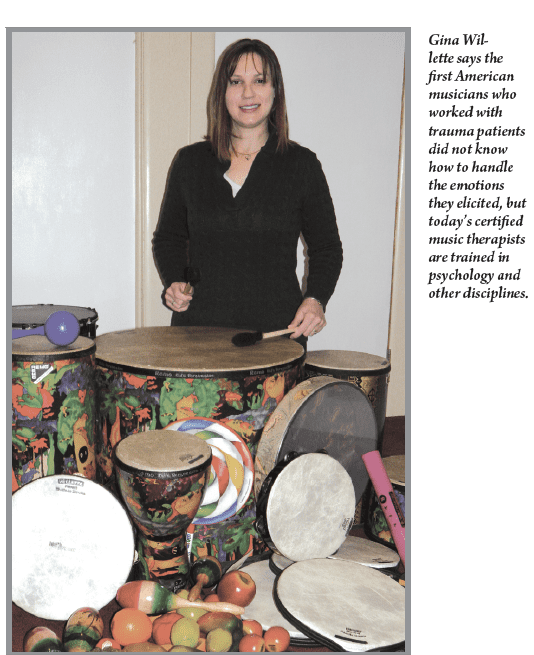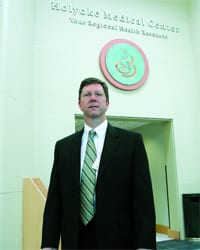Noteworthy Healing – Certified Music Therapists Strike Some Positive Chords
When U.S. Rep. Gabby Giffords was shot at point-blank range in 2011, she lost the ability to speak, as her injuries included aphasia, or damage to the language pathways in the left hemisphere of the brain where speech is controlled.
But thanks to a music therapist, Giffords learned to talk again. The therapist used techniques that created a new pathway for speech on the right hemisphere of Gifford’s brain, which was possible because music bridges both sides of the brain. The therapy included a combination of rhythm and sound, and although the first words Giffords uttered were in song, in time she regained the ability to speak without singing.
“Music encompasses so many parts of the brain,” said Rusty Williams-Russell, a board- certified music therapist and owner of Heart Beats Music Therapy in Greenfield, noting that the same pitch inflections used in speech are also found in music. “Songs help people express emotions, and 98{06cf2b9696b159f874511d23dbc893eb1ac83014175ed30550cfff22781411e5} of the population has a positive relationship with music, and all cultures use singing as a form of communication. We know that even babies in the womb process sounds.”
Williams-Russell works at Baystate Children’s Hospital in Springfield, and says he can put uncomfortable babies to sleep with music that mirrors the exact pitch of their crying. “It’s a technique called ‘holding,’ and it’s used to comfort a child, which I’m able to do with my voice and guitar,” he told HCN. “If the technique doesn’t work, you know something is really wrong.”
Board-certified music therapists work in a variety of settings with specific goals, but local experts say many people don’t understand how the modality differs from simply listening to soothing music.
“It’s not entertainment — it’s an interactive process that focuses on the individual and their needs, using music as a tool,” explained board-certified music therapist Gina Willette of Grace Notes Music Therapy in South Hadley, who also holds certifications in hospice and palliative care and as a dementia practitioner.

The practice of using music as a healing medium dates back to ancient times, but the profession didn’t develop in the U.S. until it was employed in veterans’ hospitals after World War I and World War II with soldiers who had traumatic war injuries. Doctors and nurses noticed the profound effect it had on their patients, but it soon became evident that musicians did not know how to handle the emotions elicited by the songs they played or sang. So, a professional program of study was developed, which includes psychology as well as other disciplines.
“Music brings out emotion, so it’s important to know what to do with it, as there can be tears of sadness or of joy,” Willette said, adding that music therapists use the physical, emotional, mental, social, aesthetic, and spiritual effects of music to help clients improve or maintain their health.
Today, the American Music Therapy Assoc. (AMTA) says the modality is used to manage stress, alleviate pain, enhance memory, improve communication, and increase individuals’ desire to undergo rehabilitation, as well as creating an outlet for their feelings. Clinical music therapy is also used to reduce asthma attacks, to help autistic children communicate and/or gain self-control, and to teach people with Alzheimer’s disease or a brain injury to talk again. In addition, it facilitates sleep and weight gain in premature infants and increases motor function in people with Parkinson’s disease.
Sounds Impressive
In order to become board-certified, practitioners must earn a bachelor’s degree in music therapy from one of AMTA’s approved colleges and universities. Such programs include 1,200 hours of clinical training as well as the certification exam and continuing education, as the practice requires knowledge in psychology and medicine as well as music.
Sessions are conducted individually or in groups, and some insurance companies pay for treatment. Prices in Western Mass. average from about $65-$75 per hour for individual sessions to $120 a month for group sessions, and most music therapists see patients on a weekly basis. However, the cost can vary and depends on a number of factors. To find a board-certified therapist, visit www.cbmt.org.
“We set goals and document a person’s process, and no therapy is the same,” said Willette. “It has a lot to do with musical preference, musical background, and the ability to hold an instrument.”
Music therapists conduct initial assessments to determine the client’s strengths, weaknesses, capabilities, cognitive level, physical abilities, and more. “Their preferences are very important, because a song like ‘Amazing Grace,’ which is often played at funerals, can be very comforting or trigger negative emotions and memories,” Willette said, citing just one example. “We’re capable of handling emotions that arise, but need to know what people like and don’t like.”
The therapists often work in conjunction with a team and/or family members, and offer techniques that support the therapy in their clients’ lives. Clinical music therapists are employed in school systems, private homes, early-intervention centers, day-care centers, day-treatment centers, group homes, and other community settings.
“Goals range from increasing eye contact to decreasing depression and anxiety to following directions, improving impulse control, managing pain, and improving speech and articulation; music provides a non-threatening way to accomplish these goals because it is a universal language,” said Willette. “It’s not about performing; it’s a process, and a lot of times the musical instruments clients use serve as an extension of themselves. They may not be able to say what they want with words, but they can do it with music, even if they have never played an instrument before.”
One child she worked with had a short attention span, but became fascinated by his ability to make sound by passing his hand up and down the neck of her guitar. “It sounded like nails on a chalkboard, but helped him to make eye contact and stay involved with one activity because it engaged his attention and interest, which translated into a longer attention span when he is engaged in other activities,” she explained.
Williams-Russell said having a child create music with different types of instruments is far more therapeutic than simply listening to it. His work includes group sessions with children who have behavioral issues that prevent them from succeeding in school. “I use music therapy to make rules fun,” he said, adding that he makes up songs that children reply to by singing their answers. “They have to listen, pay attention, and take turns, which is a model for functioning outside the group.”
He also works in memory units for older adults, including Keystone Commons in Ludlow, Ruth’s House in Longmeadow, the Arbors in Amherst, and Orchard Valley in Wilbraham, and says songs can encourage people to start talking, even if their capacity is reduced.
Group sessions are typically conducted once a week. Williams-Russell always starts and ends with the same songs and asks simple questions in song, such as “is Julie here?” to which she responds by singing, “yes, I am.”
“And if anything comes from the group, I use it in the song,” he went on, explaining that he makes up songs for each audience as the session progresses. “I’m constantly re-evaluating.”
In some instances, Willette said, music is the only form of communication possible. For example, she had a client in a dementia unit who was in the final stages of Alzheimer’s disease. “He could only speak the word ‘honey,’ but when his wife came in, he was able to look her in the eye, hold her hand, and sing ‘Let Me Call You Sweetheart’ with her,” Willette said. “A person may not know what they had for breakfast or who their family members are, but if you play a song from the ’20s, ’30s, or ’40s, they not only sing the words, they start to recall memories from that time period. If they are still high-functioning, it can serve as an avenue to get them to talk, and if they are low-functioning, you can see their breathing relax and become more regulated.”
Williams-Russell concurred, and said singing helps people who have lost other ways to feel successful and more independent. He brings musical instruments for each person in a group to use, including shakers and maracas, as the combination of physical activity and singing engages both sides of the brain. “It can help with depression and feelings of isolation, and weekly gatherings give people a sense of security and wholeness.”
Willette has worked with many hospice patients, and said hearing is the last sense to go. But family members are often at a loss as to what to say or do when they gather around a dying person’s bedside. Her techniques can be as simple as having people take turns using an ocean drum that contains beads that sound like waves crashing when it is tilted back and forth.
Other instruments she carries include bells that can be strapped on the ankles or wrists of people with limited movement. “If people can only shake a leg, they can still dance and make music,” Willette said, adding she also uses adaptive drum mallets shaped like a T that can be held between the fingers for people who cannot grip an object.
“Sometimes you have to get very creative,” she said. “For example, I worked with a child with severe disabilities who could not hold anything. But I helped her play the drum with her feet, which made her smile and laugh.”
Chapter and Verse
Williams-Russell said music therapists also help people increase their ability to relax, and are employed in wellness programs and by businesses to improve group dynamics.
“Music can stimulate or relax you. But clinical music therapy is not something that is done for you. It is done with you, is client-centered, and involves a process,” he said.
Which can include singing, moving, talking, responding, and making music in ways that improve quality of life.



Comments are closed.